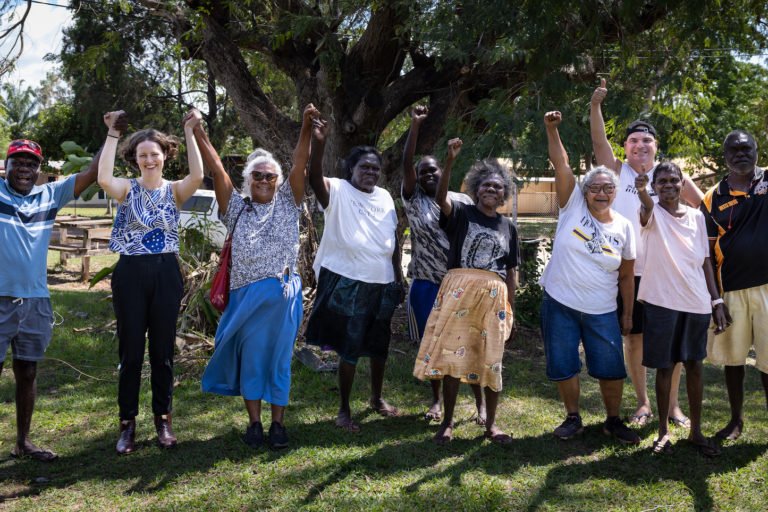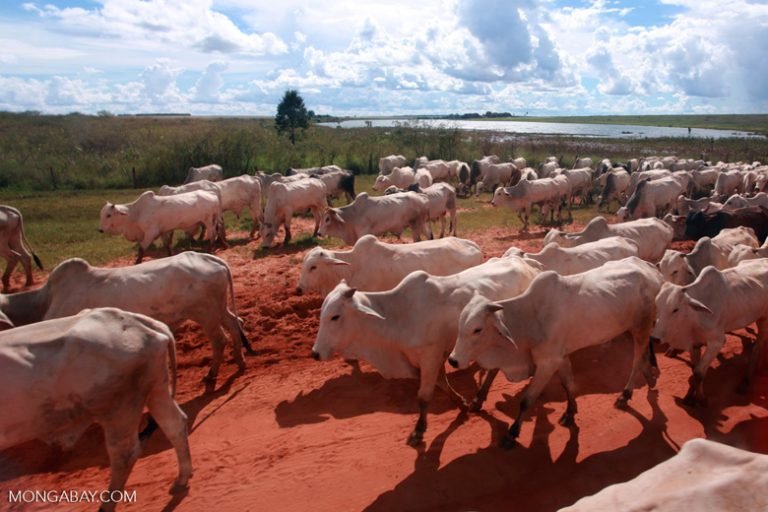- Almost a dozen countries in Latin America and the Caribbean have pledged to reach net-zero emissions by around 2050.
- Agriculture and related land-use changes are responsible for almost half of greenhouse gas emissions in the region, and ambitious changes to the food system are necessary to achieve these net-zero goals.
- A new report by the Inter-American Development Bank shows that meeting the 2050 target depends heavily on reducing the carbon footprint of beef, on both the supply and the demand sides, especially from high beef-consuming countries in the region.
Look up what drives deforestation in Latin America and the Caribbean, and the results are many: trade with countries like China and the EU, mining to satisfy growing demand for gold and other metals, speculation and land grabbing tied to U.S. universities and pension funds. While all of these are factors, one of the biggest drivers of greenhouse gas emissions in the region — and its best hope for achieving net-zero emissions by 2050 — remains the food system.
Food production and deforestation are responsible for almost half of greenhouse gas emissions in Latin America and the Caribbean, and meat plays an outsized role. More than 77% of agricultural land globally is used for livestock, either for grazing or feed production. And food demand is only expected to rise by more than 50% by 2050. In Latin America, cattle ranching is especially important: the region is home to 67% of beef cattle and 76% of dairy cattle. Beef production is expected to increase by 125% by 2050 to sustain meat demand.
Food production is an enormously important for the economy of Latin America and the Caribbean. Commodities like soy and beef are the main and often most lucrative exports for many countries, and the sector employs roughly 15% of people in the region. But at the same time, the region suffers from both increasing rates of food insecurity alongside rising rates of obesity, especially among children.
Bringing its food system, currently one of the biggest sources of greenhouse gases, to ultimately net-zero emissions in the next few decades remains a big challenge for the region, where almost a dozen countries have pledged to reach net-zero emissions by around 2050. According to a new report from the Inter-American Development Bank (IADB), reaching net zero by 2050 will require ambitious and sustained improvements in crop yields as well as dietary changes, especially in beef consumption. It calls for shrinking the proportion of land dedicated to agriculture, and increasing the area available for carbon sequestration and biodiversity preservation.
It’s a timely report, said Florence Pendrill, a researcher at Chalmers University of Technology in Sweden who studies the drivers of tropical deforestation and land use change.
“There is an increasing recognition and focus on the role of agriculture and land use in the joint crises of climate change and biodiversity loss, both coming out of the climate COP26 in Glasgow late last year, and going into the U.N. Biodiversity Conference [COP15] later this year,” Pendrill, who was not involved in the report, told Mongabay. “The IADB report considers both supply-side and demand-side measures to reduce emissions, which can be useful as countries work toward realizing these goals.”
Patrice Dumas, a co-author of the report and senior researcher at the French Agricultural Research Centre for International Development (CIRAD), said the report is largely directed at stakeholders in the region, providing a comprehensive overview of the best options for reducing emissions, alongside figures that help compare and evaluate them. What surprised him, he said, was not that cattle ranching turned out to be one of the primary ways to decarbonize the food system, but the ample opportunities to sustainably intensify the livestock sector.
“I knew that it would be big, but not that big,” Dumas said. “Latin America has always had very extensive cattle production, thanks in part to an abundance of land, and so a shift to more intensive forms of production in areas less valuable for carbon and more amenable to pasture, like savannas, presents a big opportunity.”
Supply and demand must work in tandem
The report reviews options to reduce emissions and transform the land-use system into a net carbon sink by 2050 while improving nutritional security for the region’s growing population. Providing cattle with more concentrated feed, boosting nitrogen in pasture soils, silvopasture, and improved pasture management are all some of the supply-side options that the authors identified to help intensify livestock production and bring emissions savings. They also pointed to agroforestry practices to help slash emissions from cocoa, beef, and coffee production. Demand-side solutions include switching beef for a more plant-based diet or for pork and poultry, which produce lower emissions in their production, and reducing overall beef consumption, especially in Brazil and Latin America’s South Cone (encompassing Argentina, Chile and Uruguay), where daily beef protein intake per person is three to four times higher than the global average.

But the report goes beyond just considering direct emissions. It also looks at the carbon opportunity cost of land, or at the amount of carbon that could be sequestered if land used for food production was instead used to grow native vegetation.
“With the carbon opportunity cost one can go a step further to consider also the land that is already used for agriculture — what if that land wasn’t used for agriculture? Then it could instead be used for other things, including carbon sequestration,” Pendrill said. However, she said a metric focused solely on carbon doesn’t consider other potential environmental and social impacts, such as biodiversity loss or displacement of traditional peoples.
The report also tracks separately emissions produced in Latin America and the Caribbean and emissions linked to trade, given that between a fifth and a quarter of the greenhouse gas emissions from the region’s food system are associated with agricultural products used elsewhere in the world.
Results show that, overall, reducing the carbon footprint of beef is essential to transforming Latin America and the Caribbean into a net carbon sink. The most ambitious supply-side scenario includes cultivating more cattle on less land, rapidly increasing coverage of silvopasture and other practices to dramatically improve pasture yields, and improving crop yields to meet growing food and feed demand without having to deforest more. This would reduce direct emissions by 10% compared to 2010 levels, and revert previously cleared land, which would sequester 1.33 billion metric tons of emissions a year on average — around the same amount emitted by 356 average-sized coal-fired power plants.
On the demand side, the most ambitious scenario sees a reduction of beef consumption of up to 85% in Brazil and the Southern Cone countries, and to a lesser degree in Andean countries. Countries in Central America and the Caribbean, where the average beef consumption is lower than the global average, could even see an increase in consumption. This would stabilize direct emissions, improve nutritional security across all countries, and revert formerly degraded land, which could absorb the equivalent of 1.74 billion metric tons of emissions annually, or the equivalent of taking nearly 375 million cars off the road.
Combined, these solutions could help the region reach net zero by 2050 if emissions from energy, industry and waste also undergo equally ambitious cuts, the report says.
“There are options both on the demand side and on the supply side, but really the two need to be done together,” Dumas said. Some countries, like Brazil, have already shown deep commitment to improving efficiency in crop production and land use, he added. But “ambitious action can’t just be on the supply side, it also has to be on the demand side,” Dumas said.
Talking about dietary change, especially beef, remains culturally sensitive, according to Dumas, despite overwhelming research that cutting our consumption of meat and dairy products is the single biggest way to reduce our impact on the planet. The biggest demand for beef comes from within the region itself, the report says, where people consume more than twice as much beef per capita — 9 grams per person — than the global average of 4 g. In the Southern Cone and Brazil, those numbers are even higher: 18 g and 13 g, respectively.
“Time and time again we see that it is just not possible to get the deep cuts in environmental impact we need via technological developments or shifts in production alone,” said Paul Behrens, associate professor of environmental change at Leiden University in the Netherlands who researches food and energy systems and was not involved in the report. “Saving the land and reducing the emissions from beef production is vital.”
Behrens said that although the study provides an important detailed analysis of the Latin America and Caribbean region, the big picture adds more evidence to what a growing number of studies have already shown: “While supply-side measures targeting beef do help a little, such as manure management, these reductions are not as large as simply changing diets,” Behrens said. “You need that dietary change to really get the big reductions.”
Citations:
Dumas, P., Wirsenius, S., Searchinger, T., Andrieu, A., & Vogt-Schilb, A. (2022). Options to achieve net-zero emissions from agriculture and land use changes in Latin America and the Caribbean (1337). Retrieved from Inter-American Development Bank website: https://publications.iadb.org/en/options-achieve-net-zero-emissions-agriculture-and-land-use-changes-latin-america-and-caribbean
Figueroa, D., Galicia, L., & Suárez Lastra, M. (2022). Latin American cattle ranching sustainability debate: An approach to social-ecological systems and spatial-temporal scales. Sustainability, 14(14), 8924. doi:10.3390/su14148924
(Banner image: New research looks at supply and demand options to help slash carbon emissions from cattle, one of the biggest polluting sectors in Latin America. Image by: Rhett A. Butler)











